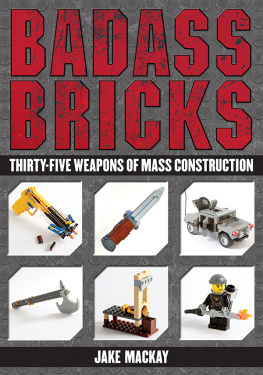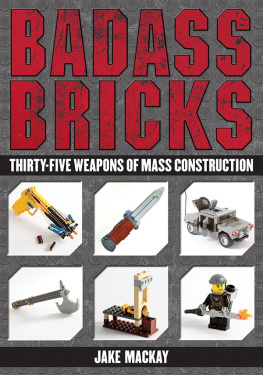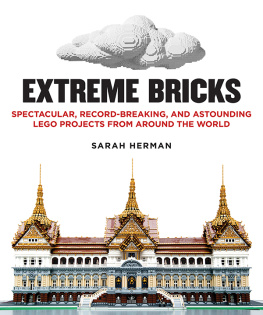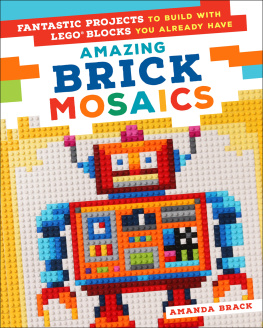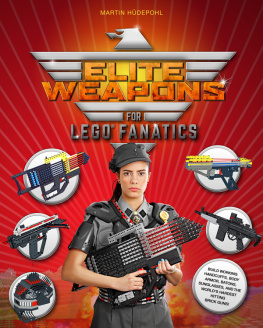BADASS
BRICKS
BADASS
BRICKS
THIRTY-FIVE WEAPONS
OF MASS CONSTRUCTION
JAKE MACKAY

LEGO is a trademark of the LEGO Group of companies which does not sponsor, authorize, or endorse this book.
Copyright 2013 by Jake Mackay
All Rights Reserved. No part of this book may be reproduced in any manner without the express written consent of the publisher, except in the case of brief excerpts in critical reviews or articles. All inquiries should be addressed to Skyhorse Publishing, 307 West 36th Street, 11th Floor, New York, NY 10018.
Skyhorse Publishing books may be purchased in bulk at special discounts for sales promotion, corporate gifts, fund-raising, or educational purposes. Special editions can also be created to specifications. For details, contact the Special Sales Department, Skyhorse Publishing, 307 West 36th Street, 11th Floor, New York, NY 10018 or .
Skyhorse and Skyhorse Publishing are registered trademarks of Skyhorse Publishing, Inc., a Delaware corporation.
Visit our website at www.skyhorsepublishing.com.
10 9 8 7 6 5 4 3 2 1
Interior layout and graphics by Nicholas Grant
Library of Congress Cataloging-in-Publication Data is available on file
ISBN: 978-1-62873-428-7
Printed in China
CHAPTER ONE
HAND-TO-HAND COMBAT
CHAPTER TWO
RANGED WEAPONS
CHAPTER THREE
HEAVY ASSAULT
CHAPTER FOUR
SPECIAL WEAPONS
INTRODUCTION
This LEGO instructional manual is an awesome, badass compilation of some of historys most destructive weapons. Included inside these pages are medieval weapons, such as the claymore sword, the war hammer, the battering ram, and the siege tower, and more modern weapons of mass destruction from the twentieth century, such as the Paris gun, the V-2 missile, the VIPeR combat robot, and the crossbow pistol.
Considering the extreme power behind these weapons and the determination of those who wielded them, the weapons in this manual are some of the most well known throughout history. The rack, a medieval torture device used for interrogation with the intention of pulling its victim limb from limb, was used throughout the Middle Ages. The Landkreuzer P. 1000 battle tank would have been larger than any military device ever built and would have weighed over one thousand tons. The M1114 Humvee was considered so awesome that a civilian version was produced for sale. No matter which weapon you choose to build, there is something awe-inspiring to discover.
This manual is divided into straightforward sections (hand-to-hand combat, ranged weapons, heavy assault, and special weapons), and each weapon is comprehensively built, piece by piece. A few of the weapons are fully functional, like the crossbow pistol, the rack, and the Landkreuzer, which can be hooked up to a battery-powered remote. The full-scale models, like the claymore sword, which is four feet in length, bring a realistic aspect to these historical weapons. At the end of this book is a Bill of Materials for each project, making it easy to see which pieces are needed for each model.
WAR HAMMER
SCALE: 1:20
A fourteenth- to fifteenth-century medieval weapon, war hammers have long shafts with an iron head that was used to strike opponents. In medieval wartime, the blunt end could not penetrate armor, but it could do significant crushing damage or create such force against an enemys helmet that it caused a concussion in the wearer. Over time, armor was produced in part with steel, which was so strong that battle-axes and swords would simply ricochet upon impact. As a result, the spiked end of the war hammer was developed to pierce weak spots in armor and impale the enemy. While most depictions are very similar to modern hammers, other examples are the squared-off, mallet-like hammer used by Thor or trolls in popular lore.



KATANA
SCALE: 1:1
The ultimate weapon of the samurai, the katana is a slender, single-edged sword that originated in Feudal Japan. Known for its strength and saber-sharp blade, the samurai sword makes its competitors look like butter knives.

FIRST HALF OF THE KATANA



SECOND HALF OF THE KATANA



FINAL ATTACHMENTS

MAQUAHUITL
SCALE: 1:1
Not your fraternitys pledge paddle. This Pre-Aztec hand-to-hand wooden club was traditionally lined with teeth-like prismatic blades made of obsidian. Sometimes up to four feet long, it could be constructed with either a one-handed or a two-handed grip, packing a razor-sharp blow that could decapitate opposing warriors. While no authentic maquahuitls have survived, they were thought to be used by Aztec military forces and may have even been wielded against sixteenth-century Spanish conquistadors.



MISERICORDE
SCALE: 1:1
With a name sounding like misery, the twelfth-century misericorde actually derives from the Latin word for mercy. Used as a form of euthanasia for mortally wounded knights, this needle-pointed dagger and its thin, steely blade could be thrust below the knights neck and down to the heart for a coup de grace, or to put him out of his misery. When used offensively, this sharp dagger could also be used to pierce through weak points in armor or stab through open eyeholes against enemies during a grapple. Offshoots of this weapon are the fifteenth-century rondel dagger and the Italian stiletto.

Next page
